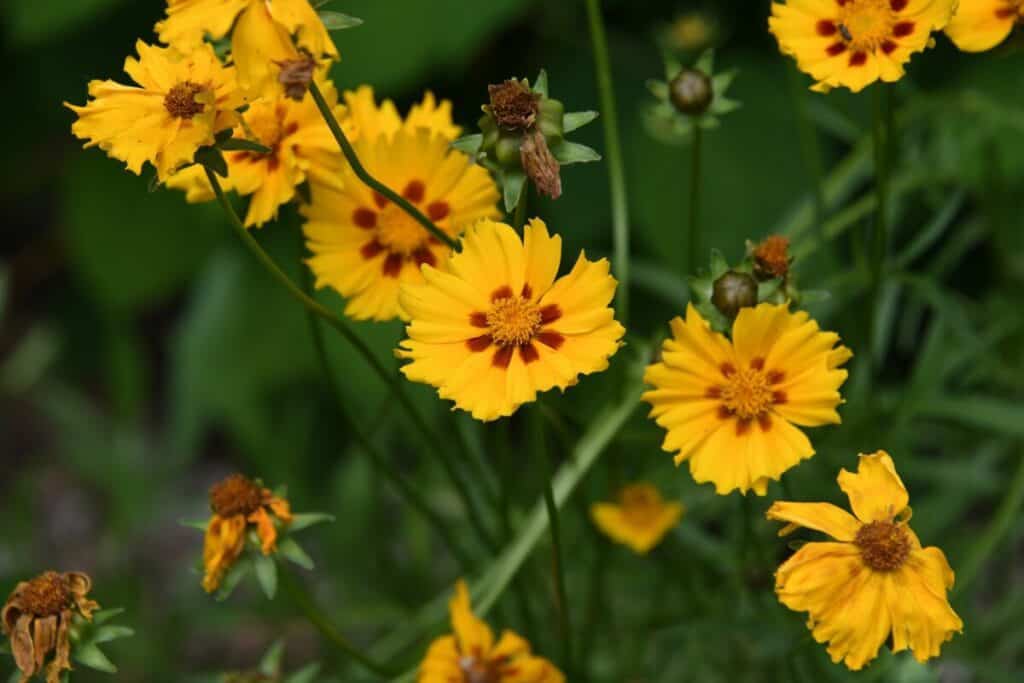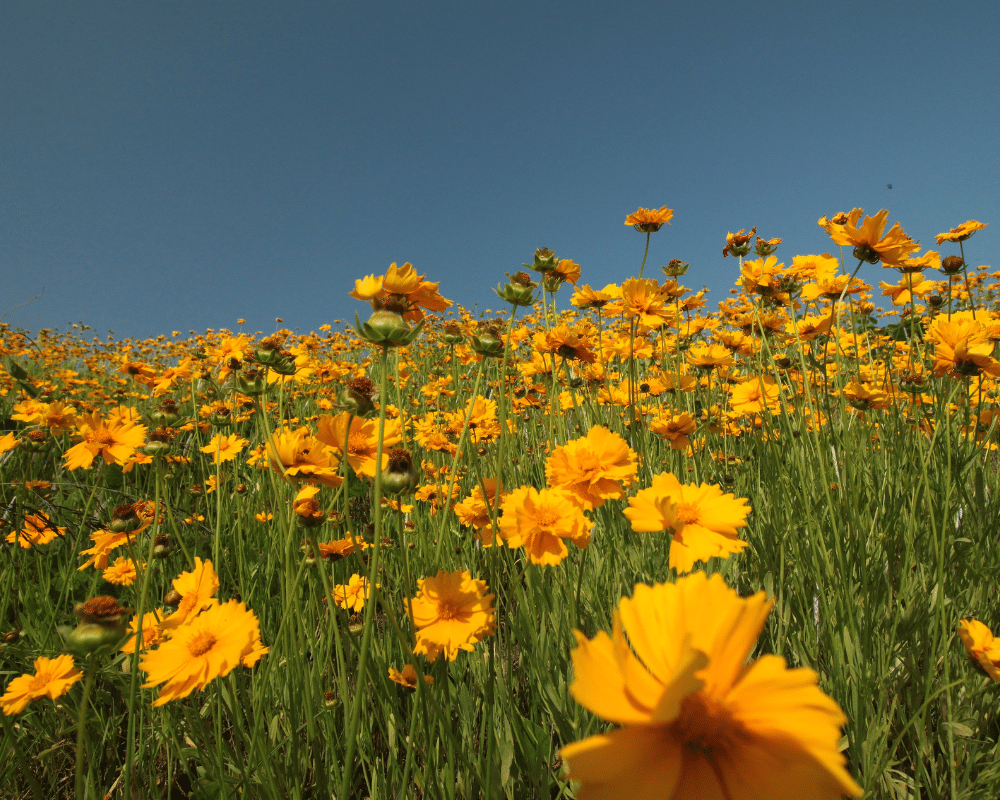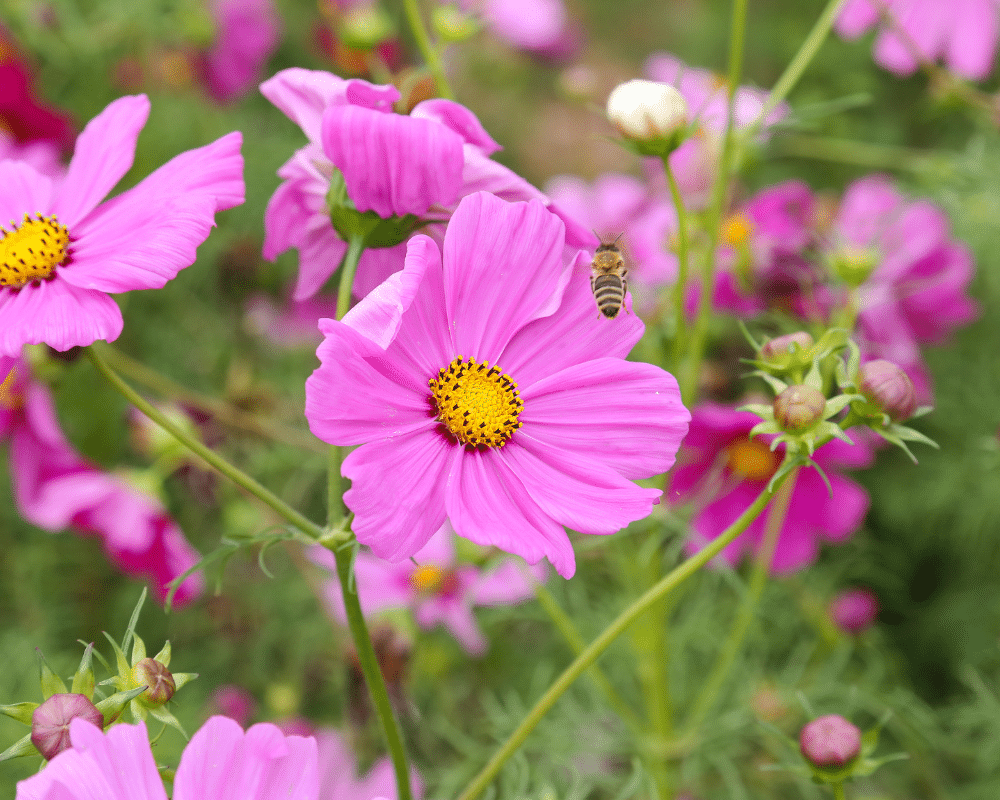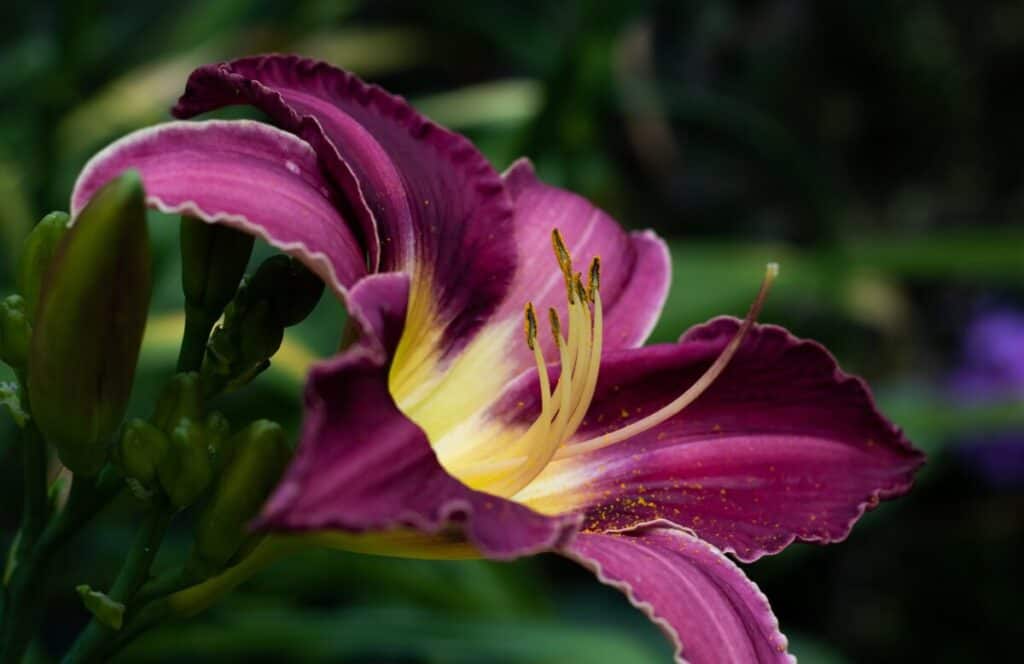Easy Care, Native Meadow Flowers
Do you have a place for a hardy, easy-care, meadow flower for bright blooms and attraction to wildlife? Here is how to grow this long-flowering native meadow flower. If daisy-like blooms (it’s in the family Asteraceae), butterflies in summer, and Goldfinch in winter sound like fun to you, read on!

Your Wildflower Meadow
Coreopsis brings us a summer of profuse blooms, often in sunny shades of yellow, and are low maintenance, disease-resistant, and bring delightful wildlife for our entertainment. ‘
The Special Charm of Coreopsis

A memorable feature of Coreopsis is that the large and profuse blooms stand above the ground on thin, tall stems. In any breeze at all, the flowers appear to dance throughout the day. It is fun to watch a chubby bee land on blossom to take a little joy ride!
You do not need a big space, but if you like the naturalized, wildflower meadow look, somewhere in your garden this is a perfect plant. You will see blooms, heaviest early in the season, but offering flowers all summer.
Color

Historically known for brilliant yellows the plant hybridizers are producing a much wider range of colors for us to grow. Look for pinks, striped patterns, and brilliant ruby reds.
Leave the last few blossoms on the winter stems and be entertained by the birds who love the “tickseeds”. The seeds are small and loved by Goldfinch and other neighbors.
Coreopsis is a pollinator attractor. A three-year, Mid-Atlantic research study conducted at the Mt Cuba Center in Delaware found at least 29 species of pollinators visiting Coreopsis. Mt Cuba Coreopsis Pollinator study.
Their Name
The ancient Greeks called it Koris (bug) or Oris (looking like a bug) they were talking about the tiny seeds, and the birds were listening! We often use the name tickseed today.
Does Coreopsis Live Where You Do?
I find that the hardiness zone descriptions of Coreopsis are a little loose. I see ranges of zone 4-9 but many varieties are not suited to the northern end of those zones. If you have hot dry summers and cold winters this should be easy. The plant comes in 80 species. About 40 are native to North America and the rest are native to Central and South America.
Look specifically for varieties that grow with comfort in your zone. There are many plant growers and dealers who ship and specify their zones. If they do not, ask or use your local garden center or your county agricultural extension office. Both of these should have the very localized expertise that you require.
When To Plant Coreopsis
Plant coreopsis in early spring or early fall. I am writing this in early August and the large dealers are shipping now. Early fall planting should ensure you have root systems extending before the first frost and allow your plants to be well into growth mode in springtime. The plants are divided about every three years and this is normally done in spring.
| HEADINGS | INFORMATION |
| Plant Name, Common | Bee Balm |
| Plant Name, Botanical | Monarda didyma |
| Significant Attributes | Colorful spikes of densely packed tubular flowers |
| Color | Blue, purple, red, pink, white, yellow. |
| Scent | aromatic |
| Bloom Period | Midsummer on. In warm zones all year. |
| Hardiness Zones | 4-10 |
| Light Requirements | Full sun. |
| Soil Requirements | Well-drained, with compost, light, fertile, loamy, moist but with drainage. Never wet. |
| Soil pH | Neutral to slightly alkaline |
| Water Requirements | Water in AM. Regular water in summer, do not allow plants to stand in soggy soil in winter |
| Plant Type | Perennial, and annual versions. For zone 10 annuals last several years. |
| Garden Usage | Beds. borders, containers, cottage garden, cut flowers. |
| Size | 18:-5′. Check varieties |
| Planting Distance | 18-24″ apart. |
| Pollinators and Wildlife | Yes |
| Cautions | very few pests and diseases. |
Some Coreopsis Varieties To Plant
Most Common Types
| Category | Important Features | Hardiness Zones |
| Coreopsis tinctoria-Golden Tickseed | Annual Plant | N/A |
| Coreopsis auriculata-Mouse Eared Coreopsis | Native to southern states but hardy. leaf sections resemble mouse ears, yellow flower | 4-9 |
| Coreopsis nana | 6-8′ high, this is a dwarf mouse-ear variety | 4-9 |
| Coreopsis grandiflower | large flowers, short-lived, 2-3 years | 4-9 |
| Coreopsis lanceolata | native to the southeast, naturalized in midwest and northeast, golden daisy | |
| Coreopsis rosea | Native from Nova Scotia, to Maryland, has rose-pink summer flowers | 4-9 |
| Coreopsis verticulata-threadleaf | Tall, 18-36″ spread of 2-3′. Yellow summer flowers. |
Cultivars
To see cultivars see the websites of major dealers.
How To Grow Coreopsis
Planting Coreopsis
Plant in a full sun location in which the soil is well-drained. Do not utilize waterlogged areas. Work organic matter into the first 6-8″ of soil. Sun and drainage are the operative issues for coreopsis. Sandy, rocky soil is not much of an issue. Give coreopsis what it really needs and it will shrug off the rest.
Trimming and Pruning
Deadhead the flowers to ensure robust blossoms. After the first spring blooms cut the plant back and a new flush of blooms will reappear. This is a plant in which it is not advisable to cut the stems to the ground as winter comes around. Leave the stems which will protect the plant over the winter. Leave, also, the last blossoms as their seeds will bring joy to the birds and therefore to you!
Other Maintenance
The coreopsis in the right location is a hardy, easy-care plant. If planting in spring add some fertilizer, probably not when planting in early fall, as cold weather is coming.
Summary,
If a naturalized area, especially one to attract wildlife, is what you want coreopsis will please.
Companion Plantings
The best companions for coreopsis are those which readily accept the same growing conditions and especially those which share its natural style of growth.
Some ideas to consider, depending on your location, are Russian Sage, Echinacea, helenium, and daylily. Add salvia to extend the color and height of your planting area.

